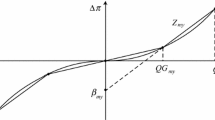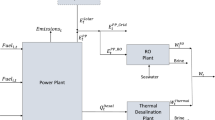Abstract
Electricity, water, and gas systems are critical infrastructures that are sustaining our daily lives. This paper studies the joint operation of these systems through a proposed optimization model and explores the advantage of considering the system of systems. Individual and joint optimizations are studied and compared. The numerical results show that the total electricity cost for these three systems can be reduced by 11.3% via joint optimization. Because the water system and gas system intrinsically include the storages in their systems, the power system can use these storages as the regulation capacity to shift load from peak hours to off-peak hours. Since the saving on the power generation cost surpasses the incremental cost in the operation and maintenance (O&M), the overall economic performance is improved by the joint optimization.
Access this chapter
Tax calculation will be finalised at checkout
Purchases are for personal use only
Similar content being viewed by others
Abbreviations
- an,bn:
-
Parameters for pricewise linearization in kW and $, respectively
- c1,c2,c3:
-
Cost coefficients for quadratic electric power curve in $/kW2, $/kW, and $, respectively
- h g :
-
Power coefficient for gas load flow in kW/(m3/h)
- h w :
-
Power coefficient for water load flow in kW/(m3/h)
- N s :
-
Number of points for piecewise linearization
- N T :
-
Number of time steps
- \( {p}_p^{\mathrm{ref}} \) :
-
Nominal pipe pressure reference in Pa
- \( {r}_e^{\prime } \) :
-
Pseudo electricity rate in $/kWh
- r e :
-
Finalized electricity rate in $/kWh
- r g :
-
O&M cost coefficient for gas storage system in $/m3
- r p :
-
O&M cost coefficient for pipe system in $/Pa
- r s :
-
Coefficient of per unit cost of gas supply in $/unit
- r w :
-
O&M cost coefficient for water system in $/m3
- \( {S}_p^{\mathrm{ref}} \) :
-
Nominal pipe storage reference in m3
- t :
-
Time index
- T :
-
Time step constant in hour
- V g :
-
Volume of one unit gas in gas transportation in m3/unit
- λn(t):
-
Ancillary variable for pricewise linearization
- Lr(t):
-
Residential electricity load at time t in kW
- Lg(t):
-
Gas load at time t in m3/h
- Lw(t):
-
Water load at time t in m3/h
- m(t):
-
Gas transportation decision variable at time t in per unit
- pp(t):
-
Pipe pressure status at time t in Pa
- Pe(t):
-
Residential electric load (non-infrastructure electric load) at time t in kW
- Pg(t):
-
Gas system electric load at time t in kW
- Pw(t):
-
Water system electric load at time t in kW
- Qg(t):
-
Gas flow rate at time t in m3/h
- Qw(t):
-
Water flow rate at time t in m3/h
- Sg(t):
-
Gas tank storage status at time t in m3
- Sp(t):
-
Gas pipe storage status at time t in m3
- Sw(t):
-
Water storage status at time t in m3
References
Liu, Y., Qu, Z., **n, H., & Gan, D. (2017). Distributed real-time optimal power flow control in smart grid. IEEE Transactions on Power Systems, 32(5), 3403–3414.
Ormsbee, L. E., & Lansey, K. E. (1994). Optimal control of water supply pum** systems. Journal of Water Resources Planning and Management, 120(2), 237–252.
Solgi, M., Bozorg-Haddad, O., Seifollahi-Aghmiuni, S., Ghasemi-Abiazani, P., & Lóaiciga, H. A. (2016). Optimal operation of water distribution networks under water shortage considering water quality. Journal of Pipeline Systems Engineering and Practice, 7(3), 04016005.
Zavala, V. M. (2014). Stochastic optimal control model for natural gas networks. Computers and Chemical Engineering, 64, 103–113.
Afshar, M. H. & Rohani, M. (2009) Optimal operation of pipeline systems using genetic algorithm. In Evolutionary computation, 2009. CEC’09. IEEE congress on (pp. 1399–1405). IEEE.
Gopalakrishnan, A., & Biegler, L. T. (2013). Economic nonlinear model predictive control for periodic optimal operation of gas pipeline networks. Computers and Chemical Engineering, 52, 90–99.
Bagchi, A., Sprintson, A., Guikema, S., Bristow, E., & Brumbelow, K. (2010). Modeling performance of interdependent power and water networks during urban fire events. In Communication, control, and computing (Allerton), 2010 48th annual allerton conference on (pp. 1637–1644). IEEE.
Santhosh, A., Farid, A., Adegbege, A., & Youcef-Toumi, K. (2012). Simultaneous co-optimization for the economic dispatch of power and water networks. In Advances in power system control, operation and management (APSCOM 2012), 9th IET international conference on, Hong Kong, China. IET.
He, C., Wu, L., Liu, T., & Bie, Z. (2017). Robust co-optimization planning of interdependent electricity and natural gas systems with a joint n-1 and probabilistic reliability criterion. IEEE Transactions on Power Systems, 99, 1–1.
Homeland Security. (2013). Critical infrastructure security and resilience.
Water Distribution Systems. (2017). https://www.epa.gov/dwsixyearreview/drinking-water-distribution-systems
Natural Gas Distribution. (2014). https://www.eversource.com/Content/ema-g/residential/safety/gas-safety-tips/gas-pipeline-safety%0A
Bradley, H. (1977). Nonlinear programming. In Applied mathematical programming (pp. 419–464).
Dutt, G. & Tanides, C. (1999). Hourly demand curves for residential end uses in Argentina and potential for load management. In Proceedings of l5eme. Congres International des Reseaux Electriques de Distribution.
Gurung, T. R., Stewart, R. A., Beal, C. D., & Sharma, A. K. (2015). Smart meter enabled water end-use demand data: Platform for the enhanced infrastructure planning of contemporary urban water supply networks. Journal of Cleaner Production, 87, 642–654.
Zhang, X., Che, L., Shahidehpour, M., Alabdulwahab, A., & Abusorrah, A. (2016). Electricity-natural gas operation planning with hourly demand response for deployment of flexible ramp. IEEE Transactions on Sustainable Energy, 7(3), 996–1004.
Author information
Authors and Affiliations
Corresponding author
Editor information
Editors and Affiliations
Rights and permissions
Copyright information
© 2019 Springer Nature Switzerland AG
About this paper
Cite this paper
Cheng, J., Liu, Q., Hui, Q., Choobineh, F. (2019). The Joint Optimization of Critical Interdependent Infrastructure of an Electricity-Water-Gas System. In: Adams, S., Beling, P., Lambert, J., Scherer, W., Fleming, C. (eds) Systems Engineering in Context. Springer, Cham. https://doi.org/10.1007/978-3-030-00114-8_6
Download citation
DOI: https://doi.org/10.1007/978-3-030-00114-8_6
Published:
Publisher Name: Springer, Cham
Print ISBN: 978-3-030-00113-1
Online ISBN: 978-3-030-00114-8
eBook Packages: Intelligent Technologies and RoboticsIntelligent Technologies and Robotics (R0)




